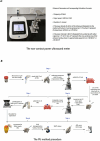A prospective study on enhanced recovery of Mycobacterium tuberculosis from children's stool using novel power ultrasound decontamination
- PMID: 40246918
- PMCID: PMC12006432
- DOI: 10.1038/s41598-025-98037-5
A prospective study on enhanced recovery of Mycobacterium tuberculosis from children's stool using novel power ultrasound decontamination
Abstract
Stool specimen is commonly used for mycobacterial culture to provide critical microbiological evidence for diagnosing tuberculosis (TB) in pediatric patients, especially when obtaining sputum specimens is challenging. However, the utilization of stool specimens for mycobacterial culture continues to face significant challenges in clinical practice, mainly owing to the relatively low diagnostic sensitivity and the frequent contamination by intestinal flora during specimen processing. This study evaluated the effectiveness of power ultrasound (PU) method in improving the recovery of Mycobacterium tuberculosis (M. TB) from stool specimens collected from children suspected of pulmonary tuberculosis (PTB). A total of 252 stool specimens were collected, and each specimen was subsequently divided into approximately three equal groups. One stool specimen was subjected to direct acid-fast bacilli (AFB) smear microscopy, while the other two stool specimens were processed using different decontamination methods(NaOH-NALC method vs. PU method). Out of the 252 specimens, positive cultures were observed in 14 (5.56%) stool specimens treated with the NaOH-NALC method, including M. TB (n = 11, 4.37%) and non-tuberculous mycobacteria (NTM; n = 3, 1.19%). Similarly, among the stool specimens subjected to the PU method, culture positivity was found in 36 (14.28%), comprising of M. TB (n = 24, 9.52%) and NTM (n = 12, 4.76%). The statistical analysis revealed a significant difference in the isolation rate of M. TB and NTM between the two methods (P<0.001). Furthermore, the contamination rate of stool treated with the PU method (14.28%) is significantly lower than that of the NALC-NaOH method (22.62%). In conclusion, our findings indicate that the PU method is a rapid and effective decontamination method for stool in children, improving the detection of active TB among pediatric populations when compared to the NALC-NaOH method.
Keywords: Mycobacterium tuberculosis; Children; Mycobacterial culture; N-Acetyl-L-Cysteine (NALC)-sodium hydroxide (NaOH); Power ultrasound; Stool.
© 2025. The Author(s).
Conflict of interest statement
Declarations. Competing interests: The authors declare no competing interests. Ethics approval and consent to participate: The experimental protocol was developed in accordance with the ethical guidelines of the Helsinki Declaration and received approval from the Ethical Committee of Shandong Public Health Clinical Center (Approval No. GWLCZXEC2023-61). Written informed consent was obtained from all individual participants and their guardians.
Figures



Similar articles
-
Comparison of Power Ultrasound and NALC-NaOH Decontamination Methods for Stool Mycobacterial Culture: A Prospective Study.Microorganisms. 2024 Aug 30;12(9):1799. doi: 10.3390/microorganisms12091799. Microorganisms. 2024. PMID: 39338473 Free PMC article.
-
Comparison of Sputum Treated with Power Ultrasound and Routine NALC-NaOH Methods for Mycobacterial Culture: A Prospective Study.J Clin Med. 2022 Aug 11;11(16):4694. doi: 10.3390/jcm11164694. J Clin Med. 2022. PMID: 36012934 Free PMC article.
-
Novel hypertonic saline-sodium hydroxide (HS-SH) method for decontamination and concentration of sputum samples for Mycobacterium tuberculosis microscopy and culture.J Med Microbiol. 2008 Sep;57(Pt 9):1094-1098. doi: 10.1099/jmm.0.2008/001339-0. J Med Microbiol. 2008. PMID: 18719178
-
Xpert MTB/RIF and Xpert MTB/RIF Ultra assays for active tuberculosis and rifampicin resistance in children.Cochrane Database Syst Rev. 2020 Aug 27;8(8):CD013359. doi: 10.1002/14651858.CD013359.pub2. Cochrane Database Syst Rev. 2020. Update in: Cochrane Database Syst Rev. 2022 Sep 6;9:CD013359. doi: 10.1002/14651858.CD013359.pub3. PMID: 32853411 Free PMC article. Updated.
-
Diagnostic Accuracy of Stool Xpert MTB/RIF for Detection of Pulmonary Tuberculosis in Children: a Systematic Review and Meta-analysis.J Clin Microbiol. 2019 May 24;57(6):e02057-18. doi: 10.1128/JCM.02057-18. Print 2019 Jun. J Clin Microbiol. 2019. PMID: 30944200 Free PMC article.
References
-
- World Health Organization (WHO). Global Tuberculosis Report. http://www.who.int/tb/publications/global_report/en/. (Accessed 7 May 2024). (2023).
-
- Sturm, R. A three-dimensional model of tracheobronchial particle distribution during mucociliary clearance in the human respiratory tract. Z. Med. Phys. 23(2), 111-9. 10.1016/j.zemedi.2013.02.004. (2013). - PubMed
MeSH terms
Grants and funding
LinkOut - more resources
Full Text Sources
Medical

